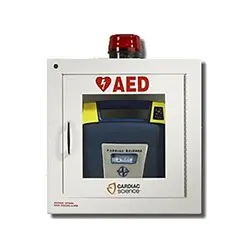AED Misconceptions
AEDs are complicated, highly specialized medical devices. As a result, they can be very intimidating and even frightening for people to imagine having to use in an emergency situation. We have all seen the movies where, during a scene of high drama, the device is charged and used to violently revive someone from a near death situation. While AEDs are in fact used to do just that, it would surprise many to learn that using the technology is not as complicated or scary as pop culture might have you believe. In fact, the devices are designed to be quite the opposite as many are built for public use with the consideration that they will most likely not be in the hands of the most highly trained medical professionals.
Here is some insightful knowledge that will hopefully serve to educate and calm those who are feeling anxious about AEDs and their usage:
– You can kill or hurt someone with an AED: AEDs are highly regulated and tested Class III medical devices. What this means is that the FDA needs to approve all aspects of the device to deem it safe. Again, Hollywood may be to blame for this fear as many movies depict characters using AEDs as weapons or to shock and immobilize other people. Thankfully, AEDs are able to analyze the heart rhythm of whoever they are pressed against and simply will not deliver a shock to a person who is not in need of one. The idea of blowing someone across the room with a blast to the chest is pure Hollywood nonsense.
– Only trained professionals can use AEDs: While proper CPR and AED training is an invaluable asset for anyone, you do not need to be a medical professional to properly administer a shock from an AED. In fact, AEDs are equipped with audio and voice prompts made to walk the user through the process. These devices are created to save lives. As a result, they have been designed for ease of use.
– AEDs aren’t necessary in places where most of the people present are young and healthy: While heart attacks are the blocking of an artery that usually occurs in people who are overweight or have pre-existing health conditions, sudden cardiac arrest (SCA) is a misfiring of electrical impulses in the heart and can happen to anyone of any age in any condition from young children to athletes in their physical peak. A heart attack victim cannot be assisted by an AED, as a physical blockage requires manual treatment. However, AEDs are designed for treating victims of cardiac arrest and are therefore invaluable tools in any environment.
– Using an AED on a person will cause them to violently convulse: Another Hollywood myth. While the person’s shoulders will most likely rise upon shock delivery, their arms and legs will remain stationary and they will not flail about.
– AEDs can shock those who are using them: This is a common misconception. As stated previously, an AED will only discharge if it has determined that the person it is being used by requires it to do so. The user is in no risk of being shocked.
– AEDs are one time use devices: Depending on a variety of factors, AEDs can deliver tens or even hundreds of discharges with proper maintenance.
– First responders are close by so an AED is not necessary: In emergency situations, time rarely feels as though its on your side. Response time can vary and mere seconds can be the difference between life and death for a victim of cardiac arrest. Proper CPR training and an accessible, properly maintained AED are your absolute best resources to prevent loss of life in the event of a cardiac arrest.



